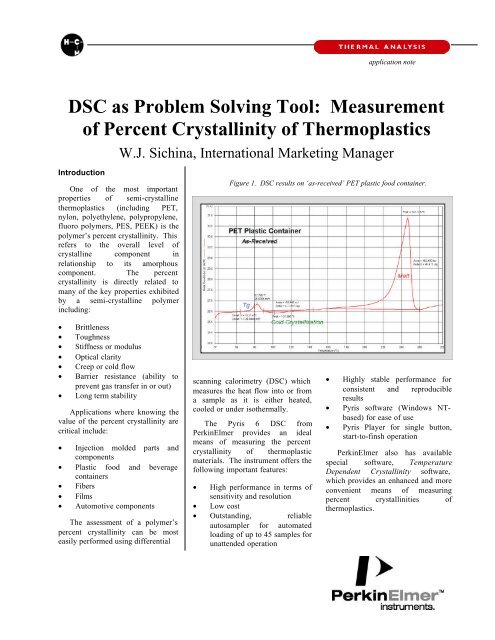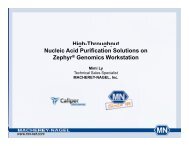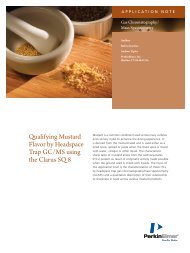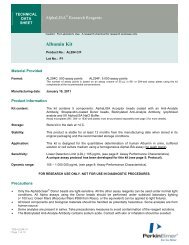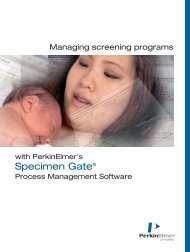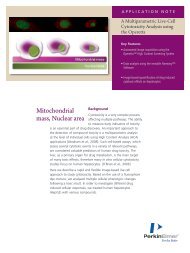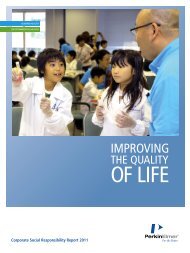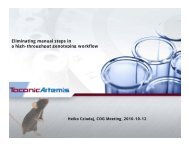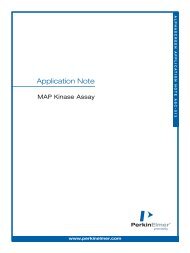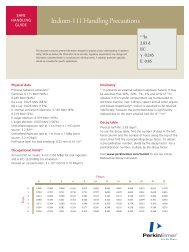DSC as Problem Solving Tool: Measurement of ... - PerkinElmer
DSC as Problem Solving Tool: Measurement of ... - PerkinElmer
DSC as Problem Solving Tool: Measurement of ... - PerkinElmer
Create successful ePaper yourself
Turn your PDF publications into a flip-book with our unique Google optimized e-Paper software.
<strong>DSC</strong> <strong>as</strong> <strong>Problem</strong> <strong>Solving</strong> <strong>Tool</strong>: Me<strong>as</strong>urement<br />
<strong>of</strong> Percent Crystallinity <strong>of</strong> Thermopl<strong>as</strong>tics<br />
Introduction<br />
One <strong>of</strong> the most important<br />
properties <strong>of</strong> semi-crystalline<br />
thermopl<strong>as</strong>tics (including PET,<br />
nylon, polyethylene, polypropylene,<br />
fluoro polymers, PES, PEEK) is the<br />
polymer’s percent crystallinity. This<br />
refers to the overall level <strong>of</strong><br />
crystalline component in<br />
relationship to its amorphous<br />
component. The percent<br />
crystallinity is directly related to<br />
many <strong>of</strong> the key properties exhibited<br />
by a semi-crystalline polymer<br />
including:<br />
• Brittleness<br />
• Toughness<br />
• Stiffness or modulus<br />
• Optical clarity<br />
• Creep or cold flow<br />
• Barrier resistance (ability to<br />
prevent g<strong>as</strong> transfer in or out)<br />
• Long term stability<br />
Applications where knowing the<br />
value <strong>of</strong> the percent crystallinity are<br />
critical include:<br />
• Injection molded parts and<br />
components<br />
• Pl<strong>as</strong>tic food and beverage<br />
containers<br />
• Fibers<br />
• Films<br />
• Automotive components<br />
The <strong>as</strong>sessment <strong>of</strong> a polymer’s<br />
percent crystallinity can be most<br />
e<strong>as</strong>ily performed using differential<br />
W.J. Sichina, International Marketing Manager<br />
scanning calorimetry (<strong>DSC</strong>) which<br />
me<strong>as</strong>ures the heat flow into or from<br />
a sample <strong>as</strong> it is either heated,<br />
cooled or under isothermally.<br />
The Pyris 6 <strong>DSC</strong> from<br />
<strong>PerkinElmer</strong> provides an ideal<br />
means <strong>of</strong> me<strong>as</strong>uring the percent<br />
crystallinity <strong>of</strong> thermopl<strong>as</strong>tic<br />
materials. The instrument <strong>of</strong>fers the<br />
following important features:<br />
• High performance in terms <strong>of</strong><br />
sensitivity and resolution<br />
• Low cost<br />
• Outstanding, reliable<br />
autosampler for automated<br />
loading <strong>of</strong> up to 45 samples for<br />
unattended operation<br />
application note<br />
Figure 1. <strong>DSC</strong> results on ‘<strong>as</strong>-received’ PET pl<strong>as</strong>tic food container.<br />
• Highly stable performance for<br />
consistent and reproducible<br />
results<br />
• Pyris s<strong>of</strong>tware (Windows NTb<strong>as</strong>ed)<br />
for e<strong>as</strong>e <strong>of</strong> use<br />
• Pyris Player for single button,<br />
start-to-finsh operation<br />
<strong>PerkinElmer</strong> also h<strong>as</strong> available<br />
special s<strong>of</strong>tware, Temperature<br />
Dependent Crystallinity s<strong>of</strong>tware,<br />
which provides an enhanced and more<br />
convenient means <strong>of</strong> me<strong>as</strong>uring<br />
percent crystallinities <strong>of</strong><br />
thermopl<strong>as</strong>tics.
Me<strong>as</strong>urement <strong>of</strong> Percent<br />
Crystallinity<br />
As an example <strong>of</strong> the practical<br />
importance <strong>of</strong> knowing the percent<br />
crystallinity <strong>of</strong> polymers, a major<br />
food company recently had<br />
problems with their pl<strong>as</strong>tic ketchup<br />
bottles. Some consumers noted that<br />
the ketchup bottles contained<br />
significantly less ketchup than<br />
specified on the label. The state<br />
authorities were notified and they<br />
verified that the ketchup w<strong>as</strong> not up<br />
to specified levels. The ketchup<br />
bottles from this particular food<br />
company were removed from the<br />
store shelves and the company w<strong>as</strong><br />
fined. It w<strong>as</strong> later found that the<br />
pl<strong>as</strong>tic bottles were defective (due to<br />
a greater concentration <strong>of</strong> recyclates<br />
in the pl<strong>as</strong>tic) and were less<br />
crystalline that they should have<br />
been. The lower crystallinity <strong>of</strong> the<br />
bottle permitted the water in the<br />
ketchup to seep through to the<br />
outside (poor barrier resistance) and<br />
this led to the decre<strong>as</strong>e in the weight<br />
<strong>of</strong> the ketchup inside the bottle.<br />
Testing <strong>of</strong> the pl<strong>as</strong>tic bottles with<br />
<strong>DSC</strong> would have shown that the<br />
bottles were defective with lower<br />
than desired percent crystallinity.<br />
To perform this important<br />
percent crystallinity me<strong>as</strong>urement,<br />
approximately 10 mg <strong>of</strong> the sample<br />
is cut from the test specimen and<br />
accurately weighed. The following<br />
test conditions are used to me<strong>as</strong>ure<br />
the sample’s crystallinity:<br />
Initial<br />
temperature:<br />
Final<br />
temperature:<br />
Heating rate: 10 C/min<br />
Visit our website at www.perkinelmer.com.<br />
<strong>PerkinElmer</strong> Instruments<br />
761 Main Avenue<br />
Norwalk, CT 06859-0010 USA<br />
Tel: 80O-762-4000 or<br />
(1+) 203-762-4000<br />
Fax: (1+) 203-762-4228<br />
Room temperature<br />
30 C above melting<br />
temperature <strong>of</strong><br />
polymer<br />
Purge g<strong>as</strong>: Approximately 10<br />
mg<br />
Sample pan: Crimped aluminum<br />
pan<br />
The heats <strong>of</strong> melting, ΔHm, and<br />
cold crystallization, ΔHc, are<br />
determined by integrating the are<strong>as</strong><br />
(J/g) under the peaks. Depending<br />
upon the sample’s given thermal<br />
history, a cold crystallization<br />
exothermic peak may or may not be<br />
observed during the <strong>DSC</strong><br />
experiment.<br />
The percent crystallinity is then<br />
determined using the following<br />
equation:<br />
% Crystallinity = [ΔHm – ΔHc] / ΔHm°<br />
• 100%<br />
In this equation, the heats <strong>of</strong><br />
melting and cold crystallization are<br />
in terms <strong>of</strong> J/g. The term ΔHm° is a<br />
reference value and represents the<br />
heat <strong>of</strong> melting if the polymer were<br />
100% crystalline. This reference<br />
heat <strong>of</strong> melting h<strong>as</strong> been established<br />
for each <strong>of</strong> the commonly used<br />
polymers and some <strong>of</strong> these are<br />
listed below<br />
Polymer ΔHm° (J/g)<br />
Nylon 6 230.1<br />
Nylon 6,6 255.8<br />
PET 140.1<br />
Polypropylene 207.1<br />
Polyethylene 293.6<br />
The <strong>PerkinElmer</strong> Temperature<br />
Dependent Crystallinity s<strong>of</strong>tware<br />
directly provides these values to<br />
make the <strong>as</strong>sessment <strong>of</strong> the percent<br />
crystallinity more convenient and<br />
e<strong>as</strong>ier.<br />
©2000 <strong>PerkinElmer</strong>, Inc. Printed in U.S.A.<br />
Percent Crystallinity Results from<br />
PET Container<br />
Polyethylene terephthalate (PET) is<br />
widely utilized for the production <strong>of</strong> food<br />
and beverage containers. PET bottle<br />
resins provide good impact resistance,<br />
good optical clarity and barrier resistance,<br />
provided that the resin achieves a proper<br />
percent crystallinity during production.<br />
PET containers are manufactured using a<br />
blow molding process where the resin is<br />
melted, injected into a mold were the resin<br />
<strong>as</strong>sumes the temporary shape <strong>of</strong> a tube.<br />
Pressurized air is then introduced into the<br />
tube, which then expands the shape <strong>of</strong> the<br />
container to its final form. As this occurs,<br />
the resin acquires a certain level <strong>of</strong><br />
crystallinity which then affects the final<br />
properties <strong>of</strong> the container including<br />
optical clarity, g<strong>as</strong> permeability, impact<br />
resistance, stiffness, resistance to creep,<br />
etc.<br />
Displayed in Figure 1 are the <strong>DSC</strong><br />
results, generated on the <strong>PerkinElmer</strong><br />
Pyris 6 <strong>DSC</strong> instrument, for an ‘<strong>as</strong>received’<br />
PET container.<br />
The <strong>as</strong>-received bottle resin shows<br />
three distinct transitions, all <strong>of</strong> which<br />
are key to the properties exhibited by<br />
the container:<br />
Tg or gl<strong>as</strong>s transition at 75 C<br />
where the resin undergoes s<strong>of</strong>tening<br />
Cold crystallization at 101 C (ΔHc<br />
= 1.65 J/g) where the polymer<br />
undergoes some small amount <strong>of</strong><br />
crystallization while heating in the<br />
<strong>DSC</strong><br />
Melting at 247 C (ΔHm = 46.5 J/g)<br />
where the existing crystalline<br />
component is destroyed<br />
The percent crystallinity <strong>of</strong> this<br />
particular PET food container can be<br />
<strong>as</strong>sessed b<strong>as</strong>ed on these <strong>DSC</strong> results<br />
and b<strong>as</strong>ed on the theoretical heat <strong>of</strong><br />
melting for 100% crystalline PET:<br />
PETech-40<br />
Thermal Analysis
Figure 2. <strong>DSC</strong> results from PET container resin after being annealed at 180 C<br />
for 3 minutes.<br />
Figure 3. <strong>DSC</strong> results on quench cooled PET container resin.<br />
% crystallinity = (46.5 – 1.65) /<br />
140.1 • 100%<br />
% crystallinity = 32.0%<br />
Knowing this value is critical for<br />
a food container <strong>as</strong>, if the value is<br />
Visit our website at www.perkinelmer.com.<br />
<strong>PerkinElmer</strong> Instruments<br />
761 Main Avenue<br />
Norwalk, CT 06859-0010 USA<br />
Tel: 80O-762-4000 or<br />
(1+) 203-762-4000<br />
Fax: (1+) 203-762-4228<br />
too low, the barrier resistance will<br />
be low and its creep propensity will<br />
be high. Similarly, if the percent<br />
crystallinity is too high, the<br />
container may suffer with regards to<br />
©2000 <strong>PerkinElmer</strong>, Inc. Printed in U.S.A.<br />
its impact and optical clarity<br />
properties.<br />
In order to enhance the properties<br />
<strong>of</strong> the PET resin for certain packaging<br />
applications, the blow molded bottle<br />
may be held at an elevated<br />
temperature between Tg and Tm to<br />
stabilize the properties <strong>of</strong> the resin and<br />
to produce an incre<strong>as</strong>e in the<br />
container’s Tg. This will allow the<br />
container to be used for more critical<br />
barrier resistance uses, such <strong>as</strong> storage<br />
<strong>of</strong> orange juice, milk and beer. The<br />
PET container resin w<strong>as</strong> annealed for<br />
3 minutes at 180 C in order to produce<br />
changes in the structure or<br />
morphology <strong>of</strong> the resin and the <strong>DSC</strong><br />
results for the annealed resin are<br />
displayed in Figure 2.<br />
The Tg or s<strong>of</strong>tening temperature<br />
incre<strong>as</strong>ed by about 20 C to 93 C,<br />
which is important for better storage<br />
<strong>of</strong> g<strong>as</strong> sensitive liquids such <strong>as</strong> orange<br />
juice or beer<br />
The cold crystallization peak<br />
disappears entirely<br />
A heat set, pre-melting<br />
endothermic peak is observed at 188<br />
C which reflects the annealing<br />
processing step<br />
The overall level <strong>of</strong> crystallinity <strong>of</strong><br />
the PET container resin is<br />
significantly incre<strong>as</strong>ed<br />
The percent crystallinity <strong>of</strong> the<br />
annealed container resin is calculated<br />
<strong>as</strong>:<br />
% crystallinity = 55.5 / 140.1 • 100%<br />
% crystallinity = 39.6%<br />
These results demonstrate that the<br />
brief annealing step produces a much<br />
higher Tg (75 versus 93 C) and a<br />
higher crystallinity (32.0% versus<br />
39.6%) for the PET food container.<br />
PETech-40<br />
Thermal Analysis
The great sensitivity to PET resin<br />
to its given processing conditions<br />
may also be demonstrated by quench<br />
cooling the resin from the melt, <strong>as</strong><br />
shown by the <strong>DSC</strong> results in Figure<br />
3.<br />
The quench cooled PET resin h<strong>as</strong><br />
an extremely low crystalline content<br />
and is nearly entirely amorphous.<br />
By cooling rapidly from the melt,<br />
the PET resin does not have time to<br />
develop a significant crystalline<br />
component. The <strong>DSC</strong> me<strong>as</strong>ured<br />
heat <strong>of</strong> melting is 44.9 J/g and the<br />
heat <strong>of</strong> cold crystallinity is 42.9 J/g.<br />
From this data, the percent<br />
crystallinity <strong>of</strong> the quench cooled<br />
PET container is given <strong>as</strong>:<br />
Visit our website at www.perkinelmer.com.<br />
<strong>PerkinElmer</strong> Instruments<br />
761 Main Avenue<br />
Norwalk, CT 06859-0010 USA<br />
Tel: 80O-762-4000 or<br />
(1+) 203-762-4000<br />
Fax: (1+) 203-762-4228<br />
% crystallinity = [44.9 – 42.9] /<br />
140.1 • 100%<br />
% crystallinity = 1.4% or essentially<br />
amorphous (0% crystallinity)<br />
Summary<br />
The me<strong>as</strong>urement <strong>of</strong> the percent<br />
crystallinity by <strong>DSC</strong> is a<br />
straightforward and e<strong>as</strong>y-to-perform<br />
test, which provides extremely<br />
valuable information on the end use<br />
properties <strong>of</strong> semi-crystalline<br />
polymers. The <strong>DSC</strong> percent<br />
crystallinity is directly related to<br />
essential properties including:<br />
optical clarity, toughness, stiffness,<br />
creep, barrier resistance, g<strong>as</strong><br />
©2000 <strong>PerkinElmer</strong>, Inc. Printed in U.S.A.<br />
permeability, and long term stability.<br />
The <strong>PerkinElmer</strong> Pyris 6 <strong>DSC</strong> is<br />
ideally suited for the me<strong>as</strong>urement <strong>of</strong><br />
the percent crystallinity <strong>as</strong> the<br />
instrument provides high performance<br />
(both sensitivity and resolution),<br />
outstanding autosampler, low cost and<br />
e<strong>as</strong>e <strong>of</strong> use with the Pyris s<strong>of</strong>tware<br />
and Pyris Player. The calculation <strong>of</strong><br />
the percent crystallinity <strong>of</strong> polymers is<br />
made more convenient with the<br />
Temperature Dependent Crystallinity<br />
<strong>DSC</strong> s<strong>of</strong>tware <strong>of</strong>fered by<br />
<strong>PerkinElmer</strong>.<br />
PETech-40<br />
Thermal Analysis


